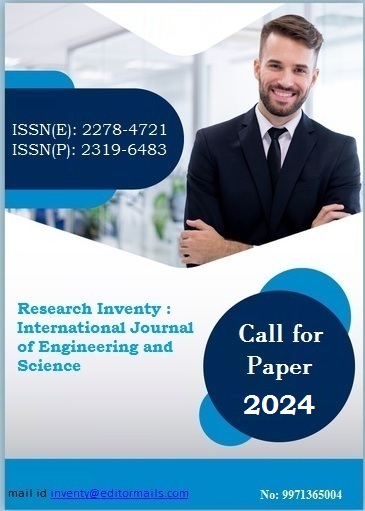Research Article ![]()
The effect of blended lignite bottom ash as a fine aggregate in concrete mixes
Αthanasios Sotirios Dounavis
Greece
Research Inventy: International Journal of Engineering & Science , Volume 10 ~ Issue 12
The use of concrete as a main material in construction industry results in Environmental damage and also in the use of more natural sources. The need for a more sustainable solution would be the replacement of concrete with other materials and especially solid wastes. It is known from literature that Coal fly ash is used extensively as a material substitute in concrete and in the present paper seems that also blended lignite ash would offer great economic and technical advantages in order to be used as a material substitute in concrete mixes. In the present experiment sample after it was blended in order to increase its pozzolanic activity with specific surface that was set at 3500 cm2/gr..........
Keywords: portland cement, coal bottom ash, characterization, leaching tests, utilization, properties of coal bottom ash, pozzolanic material, compressive strength.
Research Article ![]()
On the optimization of fermentative hydrogen production from waste glycerol: effect of pH, substrate concentration and concentration of different cations in the medium on yields and distribution of metabolites
Αthanasios Sotirios Dounavis
Greece
Research Inventy: International Journal of Engineering & Science , Volume 10 ~ Issue 12
Hydrogen is a clean, effective and renewable fuel which can be produced by different methods including biological ones, namely fermentation and biophotolysis. To improve fermentative hydrogen production the strategies, implicating use of by-products, utilization of carbon containing organic wastes and optimization of biotechnology process conditions, are developed. Glycerol, a biodiesel by-product, can serve as a cheap carbon containing source to produce hydrogen. Recent data on metabolic pathways, responsible hydrogenases and dependence of hydrogen production on external factors during glycerol fermentation are summarized. The strains are constructed to enhance hydrogen yield. In this study, hydrogen production from waste glycerol via dark fermentation was conducted by using mixed culture in both batch and continuous reactor. Furthermore, experiments have shown the best parameters and conditions about both the pH value, the effect buffer solution (Na or K) and the substrate concentration for the highest hydrogen production and metabolic products.
Keywords: hydrogen production, dark fermentation, anaerobic sludge, waste glycerol, pH, substrate concentration, optimal conditions.
Research Article ![]()
Synthesis of Some Novel Chromene Derivatives and Its Biological Evaluation
K. V. Goswami, Sarju N. Parajapati, Kokila A. Parmar
India
Research Inventy: International Journal of Engineering & Science , Volume 10 ~ Issue 12
A novel series of 2-amino-4-[2-chloro-5-(4-substitutedphenyl)pyridin-3-yl]-4H-chromene-3-carbonitrile derivatives were efficiently synthesized. Chromene (Benzopyran) was one of the privileged scaffold which appears as an important structural component in various natural products and also possess useful photochemical properties. The derivatives of benzopyran moiety can be capable of interacting with a variety of cellular targets which leads to their wide ranging biological activities such as antitumor, antihepatotoxic, antioxidant, anti-inflammatory, diuretic, anticoagulant, antispasmolytic, estrogenic, antiviral, antifungal, antimicrobial, anti-helminthic, hypothermal, vasodilatory, anti-HIV, antitubercular, herbicidal, anticonvulsant and analgesic activity. The structure of the synthesized compounds are established based on TLC, IR, NMR, MASS Spectrometric methods and elemental analyses.All the prepared compounds were screened for their antibacterial activities and antifungal activities.
Keywords: Pyrimidochromene, Amidines, antimicrobial and antifungal activity.
Research Article ![]()
Effect of electrodes' dissimilar and similar diameters on the
microstructural and mechanical properties of resistance spot
welds
Hamza ESSOUSSI, Said ETTAQI
Morocco
Research Inventy: International Journal of Engineering & Science , Volume 10 ~ Issue 12
This paper deals with the study of steel sheet welds using the resistance spot welding technique with dissimilar electrode diameters. Microstructural and mechanical properties of the performed welds were investigated using respectively optical microscope, shear and cross tensile tests, as well as micro-hardness measurements. The results revealed that the strength of welds increased with the increase of dissimilarity of electrodes' diameters. the size and the form of the obtained nuggets vary strongly with the electrode diameter.
Keywords: Resistance spot welding(RSW); Nugget size;Nugget shape; Micro-hardness;Weldability.
Research Article ![]()
Research on the Flipped Classroom Design of "Construction Project Evaluation" Based on Bloom's Taxonomy
Wu Qiong, Miao Yanyan, Zhou Zaohong
China
Research Inventy: International Journal of Engineering & Science , Volume 10 ~ Issue 12
"Construction Project Evaluation" is a subject that is biased towards practice and application. The current teaching methods are too mechanized, and there is not enough awareness of the students' main body status, and it is difficult to achieve the expected teaching effect. As an emerging teaching model, flipped classroom emphasizes the central position of students and reverses the teaching process, which is conducive to the promotion of personalized learning. The research is guided by Bloom's Taxonomy, and makes full use of the micro-class and network teaching platform to design the "Construction Project Evaluation" flipped classroom teaching mode, teaching objectives, teaching activities and assessment methods. And use textbook chapters to verify practice, which provides a useful reference for the implementation of flipped classroom.
Keywords: Bloom's Taxonomy, Construction Project Evaluation, Flipped Classroom.
Research Article ![]()
Mathematical Prediction of Biofuel´s Mechanical Properties during Densification Process
Peter Križan, Michal Svátek, Miloš Matúš, Juraj Beniak
Slovakia
Research Inventy: International Journal of Engineering & Science , Volume 10 ~ Issue 12
The main aim of this paper is to present the results of experimental research which was done on our department in laboratory conditions. Aim of the research study was to determine the effect and interaction of technological variables and material parameters during densification using mathematical modelling in order to determine the final biofuels quality and mathematical model. Also, the design of experiment (DOE), evaluation methodology for this experimental plan and research findings are presented in this paper. Experimental research dealt with the densification of selected Slovakian woods. The main goal of this experimental research was to obtain such results which can be used for mathematical models design.........
Keywords: Solid biofuel, Pressing temperature, Moisture content, Particle size, Pressing pressure, Mathematical model, DOE.

 Submit your paper
Submit your paper 